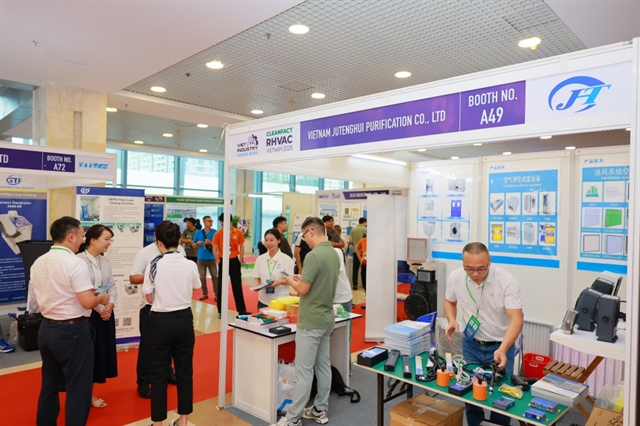HVAC and cleanroom technologies account for about 50 per cent of the show’s floor space, showcasing advanced solutions tailored to the needs of high-tech industries.

HÀ NỘI — The Viet Industry – Cleanfact – RHVAC Vietnam 2025 exhibition opened yesterday at the National Exhibition on Architecture, Planning and Construction in Hà Nội, spotlighting the country’s drive towards industrial modernisation and technological self-reliance.
Around 20 per cent of exhibitors specialise in semiconductors and data centres, while HVAC and cleanroom technologies occupy roughly half the show floor, presenting advanced solutions tailored for high-tech industries.
Key sectors such as industrial construction, mechanical engineering and electrical equipment and automation also feature prominently, highlighting their vital role in Việt Nam’s industrial value chain.
Speaking for the organisers, Director of IBC Media Đinh Hữu Vĩnh said the event comes as Việt Nam accelerates its industrialisation and integration into global value chains. The exhibition supports national strategies, including Resolution 57-NQ/TW on breakthroughs in science, technology and innovation and Resolution 68-NQ/TW on private-sector development.
Aligned with the Ministry of Industry and Trade’s Industrial Development Strategy 2025–2035, this year’s exhibition focuses on strategic industries crucial to long-term competitiveness: industrial construction, semiconductor infrastructure, data centres, HVAC, cleanroom technology, mechanical engineering and electrical equipment and automation.
According to Dr Nguyễn Xuân Tiên, vice president and secretary-general of the Việt Nam Society for Refrigeration and Air-Conditioning, the refrigeration/HVAC sector faces urgent requirements on energy saving, emissions reduction and climate adaptation.
People spend up to 80 per cent of their time indoors, so ensuring indoor air quality—including temperature and cleanliness—is critical. In the Industry 4.0 and AI era, data centres are the 'backbone' of economic development and efficient cooling and air-conditioning systems are indispensable to their operation. At the same time, refrigeration and air-conditioning consume roughly 20–30 per cent of total electricity and contribute to climate change through emissions linked to ozone-depleting substances.
Dr Tiên called on enterprises to proactively upgrade technologies and adopt green smart solutions; to join international cooperation networks; and to use the exhibition’s connections to position Vietnamese brands within the global HVAC value chain.
Highlighting opportunities to build manufacturing networks and global supply chains, Vice President of the Việt Nam Chamber of Commerce and Industry (VCCI) Hoàng Quang Phòng stressed an industrial-development strategy centred on self-reliance, green transition, higher technological content and strong connectivity platforms.
VCCI’s leadership placed special emphasis on the seminar programme, which focuses on priority trends such as semiconductors, data infrastructure, sustainable supply-chain development, competitiveness and high-tech manufacturing.
These sessions aim to share knowledge and update technologies while providing a direct forum for businesses, experts and policymakers to address bottlenecks, propose solutions and co-design development roadmaps aligned with the national industrial strategy. VNS





